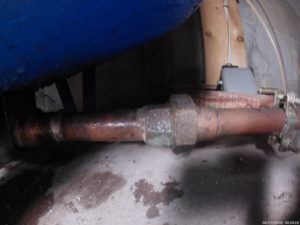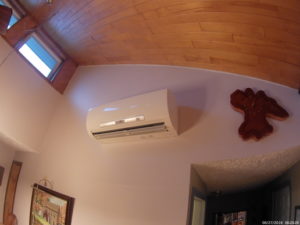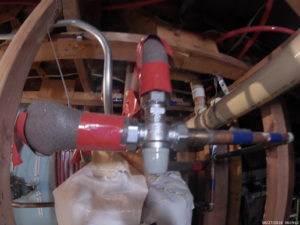I have had toilets that sweat and fixing the problem is easy. Below is why the toilet tank sweats and how to stop it.
why does my toilet sweat? A toilet sweats because the incoming water in the tank makes the outside of the tank colder than the room air temperature and the water vapor in the air “humidity” is at a high enough percentage and condenses on the outside of the cold tank. The outside of the tank temperature has hit what is called “dew point”. To stop this sweating you must either bring up the tank temperature or bring down the air humidity, The same thing happens to a glass of ice water on a hot muggy day.

How water in the air forms condensation on things
Air is made up of molecules and the distance between these air molecules increase with the temperature rise of the air. This increase of the distance between the air molecules leaves room for water molecules and this is called humidity. When the distance between the air molecules gets filled up with water the amount it gets filled up is called percentage. When it reaches 100% the air has no more room for the water molecules and it condenses causing water droplets to form. The dew point is at the temperature that these water droplets form.
This is what happens in your bathroom when you get a sweating toilet tank.
Someone takes a shower with hot water and the humidity rises because of the temperature rise of the air, this also changes the dew point, and the mist or steam from the shower injects water molecules into the air. The humidity level of the air increases and the dew point rises.
When you add a cold water to the toilet tank, after the flush and it refills, the outside of the tank temperature will drop. If the tank temperature falls below the dew point temperature then the water molecules will condense on the tank. This is the cause of sweating.
Is the tank the only part that sweats
The tank is not the only part of the toilet that can sweat. The water supply line and valve can also sweat but the surface area of these items is not as big so it is less noticeable.
Sweating is not limited to the toilet room area. If your home inside air has a high humidity percentage and you are running a faucet for a long period of time, the water supply line temperature in the wall may fall below the dew point temperature. If this happens water will condense on the supply line and it to will sweat inside of the wall.

Here is a photo of a sweating pipe under the vertical pressure tank. You can see where water from the sweating pipe has dripped onto the plywood base. (insert pic)
Here is a link to a dew point calulator (this will open a new page) https://www.calculator.net/dew-point-calculator.html
What are the parts of the toilet
A toilet is a simple machine with a few moving parts.
- Bowl
- Tank and Lid
- Fill Valve
- Flush Handle
- Flush Valve and Flapper
- Seat
How a toilet works
The toilet works with the principal of siphoning action. That is a fancy way of saying the weight of the exiting water pulls the remaining water and stuff out of the bowl down into the sewer drain.
The inside of the bowl was formed at the factory with a channel that has the shape of an “s” laying on it’s side. You may be able to see the shape on some toilets if you look down at the side of the base where the toilet bowl mounts to the floor.
The flush handle is attached to the flush valve flapper inside the tank. When you push the handle down it lifts up the flapper and releases the entire tank of water into the bowl. The bowl fills up and the water goes over the channel “s” and creates a siphoning action and draws the rest of the water out.
If you release the tank water at a slow rate this siphoning action will not happen, the tank water must be released at a fast pace for the siphoning to take place.
After the tank water has been empty the flapper drops back down over the flush valve hole and new water is released into the tank and the bowl to fill it back up again by the fill valve. When the new tank water reaches a predetermined height in the tank the float on the fill valve will close down the fill valve stopping the water.
You are ready to start the whole process again with the next flush.
Can a sweating toilet tank cause any problems
Multiple problems can arise from a sweating toilet tank.
- Mold
- Floorboard rot
- Wall paint and wallboard damage
- Slip hazard
- Draws insects
Mold spores are in the air all around us and have been linked to allergies and other ailments. If you limit the amount of mold in your house you have a healthier home. Mold needs 2 things to grow, food and water. If you take away one of those items mold can not grow.
Wooden floorboards and water are not friends. When the wood becomes wet for any amount of time bacteria will start eating away at the wood and the floor will rot. If your floor under the toilet gets rotten enough it will begin to rock when someone sits on it and at some point bust thru the floor. Removing and replacing a bathroom floor will run into thousands of dollars.
Wall paint can handle some water but not all the time. Once the paint fails then the wallboard gets wet and may be damaged. Repairing damaged wallboard is also expensive.
If you have a tile or marble floor you know how slippery they can become with standing water on them. The older you get the less likely it is you will bounce when you slip and fall. Keep the floor dry.
Carpenter ants love wet wood. Carpenter ants are big black ants that dig holes into wet wood to make their home. They are very destructive and not nice to look at. Keep your wood dry and they will not share your house. It is very expensive to repair their damage also.

How can I get the sweating to stop
To keep the outside of the toilet tank dry you must keep the humidity in the room down or keep the tank temperature up so condensation does not form.
- Install an air conditioning unit and keep your house cool. Cold air holds less water vapor.
- Install a timer of your bathroom exhaust fan. If you remove the moist air out of the house then it will not condense on the tank. This does not work if the outside air is humid.
- Install a mixing valve on the toilet water supply line. The mixing valve is attached to both hot and cold water and creates warm water to enter the tank.
- Insulate the tank with a wrap. This is not very pretty and will not totally stop the sweating.
- Install a new toilet with an insulated tank. New toilets fill up with less water and if the tank is insulated the incoming water has a chance to warm up to room temperature. This type of toilet is very hard to find.

If your toilet is old you could install a new water efficient toilet first.
You would save water and have a nice new clean toilet. This low use toilet might fix the problem because the tank takes less incoming water to fill it. The incoming water that is filling the tank has been in the supply pipes longer and will be closer to room temperature.
For the cost and effectiveness I would recommend the mixing valve. It cost between $30 – $80
The mixing valve will fix the problem and if you are handy you can install it yourself.
How to Install a New Toilet
Most people can install a new toilet. The tools you will need are minimal and the whole project should take under an hour. Here are some of the tools you will need:
- Pliers, water pump would work the best because they are adjustable for size
- Adjustable wrench or the correct size for the mounting nut
- Screwdriver, common to attach the seat if needed
- A shop vac would be nice to completely empty the water out of the tank and bowl, not required
- An old towel to wipe up any spilled water
- Metal cutting blade, hacksaw or reciprocating saw to cut the mounting bolts if they are too rusted to unscrew
- Small scraper/putty knife to clean old wax off the flange
Now the parts you will need to have on hand:
- New toilet
- New wax seal with mounting bolts, i like the one with the plastic cone to guide it to the center of the mounting flange, some new toilets come with a wax seal enclosed
- New flexible supply line will make life easier but not required if the old one will work
- New toilet seat if the toilet does not come with one
Remove the old toilet
The first thing you will want to do is turn off the water supply to the toilet. One should find the shutoff valve under the left side of the toilet. Now remove the tank top and flush the toilet. If you don’t see or hear the water running into the tank filling it back up you are in good shape, if you see water still flowing into the tank you will need to shut the water down to the bathroom or the whole house. Find where the main water supply line comes into the house and shut the valve off at that point.
*If you can not find a shutoff valve anywhere for the house you may need to hire a professional to install one and while they are there have them install the new toilet.
Once the water supply is turned off empty the tank and bowl of any remaining water with the shop vac or towel.
Using the pliers unscrew the supply line to the fill valve at the bottom of the tank. This will be located on the left. When you remove the supply line some water will spill out of the valve, about a quarter cup, this is normal.
There are two mounting bolts that hold the toilet down to the floor. You will find them on the bottom flange, one on the right and one on the left, they may have a round cover on them that will pry off using the screwdriver.
Lift the old toilet straight up or rock it forward to release it from the wax seal. The wax seal is what seals the toilet water into the drain pipe as the toilet is flushed. If you find that water comes out from under the toilet when you flush it that means the wax seal has failed and it will require replacement.
They are cheap, under $10
Dispose of the old toilet, some people use it as a planter outside.
Now scrape clean the flange on the floor to accept the new wax seal.
Install the new toilet
Remove the new toilet out of its box and review the instructions provided with it. Reading the instructions does make life easier.
Install the new mounting bolts into the mounting flange on the floor if you have them. If you are going to use the old ones, and you can if they are not too rusted, then make sure they are straight up and down and run straight with the back wall like the mounting holes on the toilets run. If you have any of the old wax seal you can use a small amount of the wax to hold the bolts in place.
You do not need to attach the tank to the bowl at this point. You can but it will make the unit heavier to lift and set into place.
Flip the new bowl on its side and press the new wax seal onto the hole on the bottom. If it has a plastic cone then have that cone facing away from the toilet, this is what guides the wax seal to the center of the mounting flange. Make sure you remove any plastic wrap off the new wax seal or it will not stick to the toilet.
Pick the toilet bowl straight up making sure not to disturb the new wax seal you just placed onto the bottom of the toilet.
Gently place the toilet bowl down onto the mounting flange using the mounting bolts as a guide. The mounting bolts will need to end sticking up thru the mounting holes of the toilet.
Now you have the toilet with the wax seal set down onto the flange set yourself down onto the new bowl. Your weight will seat the new wax seal onto the bottom of the toilet and the flange.
Using the new washers and nuts provided with the wax flange or the toilet, screw the nuts down onto the mounting bolts.
Do not tighten them down too tight or you will break the toilet and you will be buying another one.
Just snug them down so the toilet does not rock.
Now follow the instructions for assembling the tank to the bowl provided with the toilet.
Attach the water supply line to the bottom of the tank (fill valve) and turn on the water to the toilet.
Flush the toilet a few times to see if the wax seal is leaking. If the wax seal is leaking water will come out from under the toilet where it meets the floor. If this happens you can try adjusting the toilet on the flange but more than likely you will be removing the toilet off the flange and installing a new wax seal. There are fatter wax seals for flanges that are set down into the floor a bit like where the tile was installed around the flange.
Install a Mixing Valve
The cost of a mixing valve depends on the application and where you are going to install one.
They range from $20 to $150. That is a whole lot cheaper than replacing the bathroom floorboards
A mixing valve is quite a bit more complicated to install than a new toilet. If you are not comfortable working with or do not possess the tools to work with your water supply line then it might be a wise move to call a professional or a friend who can help you.
A mixing valve can be installed in a couple of places.
- In line, basement, crawl space or inside the wall
- Under the vanity
The easiest but the one that is least attractive is “ under the vanity“.
To install the mixing valve under the vanity the toilet needs to be next to the vanity so you can run the toilet supply line from the vanity to the fill valve. I say it is least attractive because one must drill a hole thru the side of the vanity for the supply line to travel. Easiest because you can use flexible water lines that tighten up with a common wrench.
The inline mixing valve is more complicated because it requires cutting your cold and hot water lines. Installing a tee into the hot water line and running a new hot water line to supply the mixing valve.
I believe if you have some mechanical ability and are willing, you can install one of these yourself.
We will be coming out with a video in the future showing the installation of each of these valves.
I hope this article has been of some help to you.
Best wishes
Gary 1/9/2018

